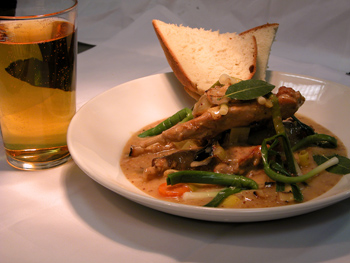Serves 4
■ 2 young rabbits or 3 older, small
ones, jointed
■ Sea salt
■ 1.5 litres (21⁄2 pints) duck fat (you
can use it at least six times)
■ 1 bulb fennel
■ 4 shallots
■ 4 cloves garlic
■ 50g (2oz) butter
■ 1 tbsp wholegrain or dijon mustard
■ Small bundle thyme sprigs
■ 1 litre (13⁄4 pints) medium cider
■ 200ml (7fl oz) double cream
■ Small bunch spring onions
Rabbit is so good at this time of year. You can usually find quite a few two- or three-month-old rabbits, which look rather on the small side but taste amazing and are always very tender. No matter what the size of the bunny, the trick is to cook the beasts gently in goose or duck fat first. This will ensure they are tender, cooked to perfection and not remotely dry.
Sprinkle the rabbit pieces in sea salt. Leave them for half an hour, then brush off the salt. Put the duck fat into a large heavy pan or casserole and add the rabbit. Then place the pan in a 130˚C/250˚F/Gas Mark 1⁄2 oven for four hours to cook the rabbit gently – not deep-fying it!
Once it is starting to come off the bone, drain the rabbit on a wire rack. You could now use it for all sorts of other dishes such as rillettes or salads or in pasta. For our purposes we will leave it in pieces.
Now finely chop the fennel, shallots and garlic, and sweat them off in the butter in a shallow pan. After five minutes on a medium heat, add the mustard and the thyme. Now pour in the cider and bring up the heat. Reduce the cider by just over half, then add the cream. Now put in the rabbit pieces, and cook them in the sauce for 10 minutes on a medium heat, turning all the time. When the rabbit is hot and the sauce is thick, it is done. Just before this point, chop the spring onions and add them to the dish to soften in the heat. Serve with fried potatoes or just a good salad and bread.





